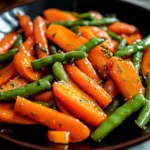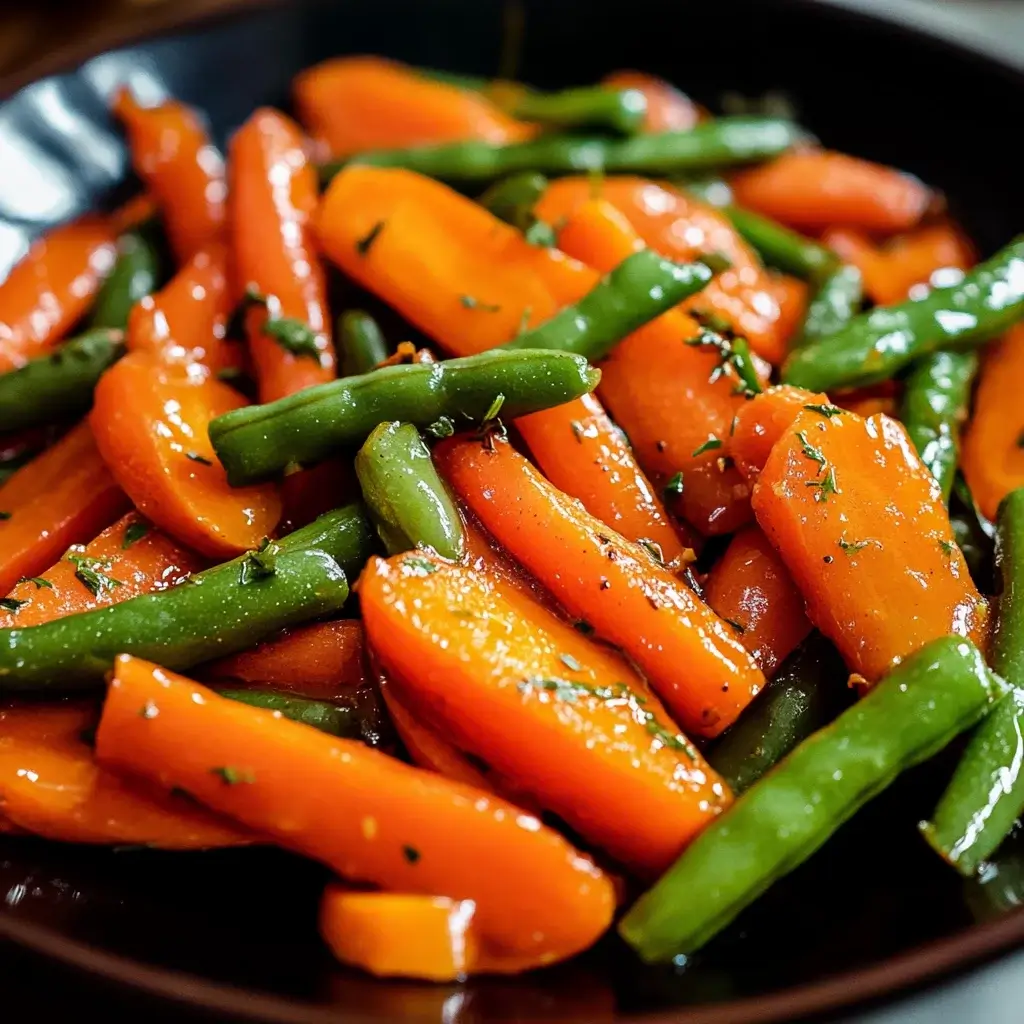From the moment I first tasted this Glazed Carrot and Green Beans recipe, I knew it was a winner. It wasn’t just the vibrant colors that popped on the plate, but the symphony of flavors – the earthy sweetness of carrots dancing with the fresh snap of green beans, all enveloped in a luscious, glossy glaze. Honestly, it’s become a staple in our household. Even my kids, who are sometimes vegetable-averse, eagerly reach for seconds. Whether it’s a simple weeknight dinner or a festive holiday gathering, this dish effortlessly elevates any meal. It’s the perfect side dish that’s both comforting and elegant, easy enough to whip up in minutes, yet impressive enough to wow your guests. The balance of sweet and savory, the tender-crisp texture – it’s simply irresistible. If you’re looking for a way to make vegetables exciting, or just want a reliable, crowd-pleasing side dish, look no further. This Glazed Carrot and Green Beans recipe is about to become your new go-to.
Ingredients
- Fresh Carrots: (1 pound) – Choose firm, bright orange carrots for the best sweetness and texture. Pre-sliced baby carrots work in a pinch for convenience, but whole carrots, peeled and sliced, offer superior flavor and texture.
- Fresh Green Beans: (1 pound) – Look for vibrant green beans that are firm and snap easily. French green beans (haricots verts) are particularly elegant, but regular green beans work just as well. Frozen green beans, thawed and patted dry, can also be used if fresh aren’t available.
- Butter: (4 tablespoons, unsalted) – Butter provides richness and flavor to the glaze. Unsalted allows you to control the saltiness of the dish. You can substitute with olive oil for a dairy-free option, but butter adds a distinct flavor that complements the vegetables beautifully.
- Brown Sugar: (1/4 cup, packed) – Brown sugar lends a warm, molasses-like sweetness and contributes to the glaze’s glossy texture. Light or dark brown sugar both work, with dark brown sugar offering a slightly deeper flavor.
- Maple Syrup: (2 tablespoons, pure) – Maple syrup enhances the sweetness and adds a nuanced, slightly caramel-like flavor that complements the brown sugar and butter. Pure maple syrup is recommended for the best taste; avoid pancake syrup, which is typically corn syrup-based.
- Soy Sauce: (2 tablespoons, low sodium) – Soy sauce provides a savory umami element that balances the sweetness of the glaze and adds depth of flavor. Low sodium soy sauce is preferred to control the overall salt content. Tamari or coconut aminos can be used as gluten-free alternatives.
- Apple Cider Vinegar: (1 tablespoon) – Apple cider vinegar adds a touch of acidity that cuts through the sweetness and brightens the flavors. It also helps to balance the overall taste and prevent the glaze from being overly sugary. White wine vinegar or lemon juice can be substituted.
- Garlic Powder: (1 teaspoon) – Garlic powder provides a subtle savory note and enhances the overall flavor profile. Fresh minced garlic can also be used (about 1-2 cloves), sautéed briefly before adding other glaze ingredients.
- Salt: (To taste) – Salt enhances all the flavors and is crucial for bringing out the best in the vegetables and glaze. Kosher salt or sea salt is recommended.
- Black Pepper: (Freshly ground, to taste) – Freshly ground black pepper adds a touch of spice and complexity to the dish. It complements the sweetness and savory notes, creating a well-rounded flavor profile.
Instructions
- Prepare the Vegetables: Begin by washing and preparing your vegetables. For the carrots, peel them and slice them into uniform rounds, about ¼ inch thick. If using baby carrots, you can halve or quarter them lengthwise if they are large. For the green beans, trim the ends and cut them in half if they are very long. Ensuring uniform sizes will help them cook evenly.
- Blanch the Green Beans (Optional but Recommended): Blanching the green beans helps to retain their vibrant green color and crisp-tender texture. Bring a pot of salted water to a rolling boil. Add the green beans and cook for 2-3 minutes, until they are bright green but still crisp. Immediately transfer them to an ice bath to stop the cooking process. Drain and set aside. This step can be skipped if you prefer a softer green bean, but blanching significantly improves the texture and color.
- Sauté the Carrots: In a large skillet or sauté pan, melt the butter over medium heat. Once the butter is melted and shimmering, add the sliced carrots. Sauté the carrots for 5-7 minutes, stirring occasionally, until they are slightly softened and beginning to become tender. This step softens the carrots and allows them to absorb the flavors of the glaze.
- Add the Green Beans (if not blanched, add with carrots): If you didn’t blanch the green beans, add them to the skillet with the carrots at this stage and sauté for another 3-5 minutes, until they begin to soften slightly but are still crisp-tender. If you blanched the green beans, add them in step 6, after the glaze is mostly reduced.
- Prepare the Glaze: In the same skillet with the carrots (and green beans if not blanched), add the brown sugar, maple syrup, soy sauce, apple cider vinegar, and garlic powder. Stir well to combine all the ingredients and dissolve the brown sugar.
- Glaze the Vegetables: Bring the glaze to a simmer and cook, stirring occasionally, until it thickens slightly and reduces to a glossy coating, about 5-7 minutes. If you blanched the green beans, add them to the skillet now and gently toss to coat them evenly with the glaze. Continue to cook for another 2-3 minutes, allowing the green beans to warm through and absorb some of the glaze flavor.
- Season and Serve: Season the glazed carrots and green beans with salt and freshly ground black pepper to taste. Be mindful of the salt content in the soy sauce and adjust accordingly. Stir gently to ensure the seasoning is evenly distributed. Serve immediately while warm. Garnish with fresh parsley or thyme, if desired, for a pop of color and freshness.
Nutrition Facts
(Per Serving, approximate)
- Servings: 6
- Calories: 150-180 kcal
- Fat: 7-9g
(Note: Nutritional values are estimates and can vary based on specific ingredients and portion sizes.)
Preparation Time
- Prep Time: 15 minutes (Includes washing, peeling, and chopping vegetables)
- Cook Time: 20 minutes (Includes sautéing vegetables and reducing the glaze)
- Total Time: 35 minutes (From start to finish, ready to serve)
This Glazed Carrot and Green Beans recipe is incredibly quick and easy to prepare, making it perfect for busy weeknights or last-minute gatherings. The active cooking time is minimal, and the results are a flavorful and satisfying side dish.
How to Serve Glazed Carrots and Green Beans
This versatile side dish pairs beautifully with a wide variety of main courses. Here are some serving suggestions:
- Classic Protein Pairings:
- Roasted Chicken or Turkey: The sweetness of the glaze complements poultry perfectly.
- Grilled Salmon or Baked Fish: A healthy and flavorful combination.
- Pork Tenderloin or Chops: The glaze cuts through the richness of pork beautifully.
- Steak or Beef Roast: Adds a touch of sweetness to balance savory beef dishes.
- Holiday and Special Occasions:
- Thanksgiving or Christmas Dinner: A vibrant and delicious addition to your holiday spread.
- Easter Brunch: The bright colors and fresh flavors are perfect for spring celebrations.
- Potlucks and Gatherings: Travels well and is always a crowd-pleaser.
- Vegetarian and Vegan Meals:
- Alongside Lentil Loaf or Nut Roast: Adds a sweet and savory vegetable element.
- With Quinoa or Couscous: Creates a balanced and satisfying vegetarian plate.
- Part of a Vegetable Platter: Adds a warm and flavorful option to a cold vegetable spread.
- Enhance the Presentation:
- Garnish with Fresh Herbs: Chopped parsley, thyme, or chives add a fresh aroma and visual appeal.
- Sprinkle with Toasted Nuts: Toasted pecans, walnuts, or almonds add a crunchy texture and nutty flavor.
- Drizzle with Balsamic Glaze (optional): For an extra touch of elegance and tangy sweetness.
- Arrange Artistically: Pile the glazed vegetables in a serving dish, creating height and visual interest.
Additional Tips for Perfect Glazed Carrots and Green Beans
- Use Fresh, High-Quality Ingredients: The best flavor comes from fresh, vibrant vegetables. Choose firm carrots and crisp green beans for optimal taste and texture. If using frozen green beans, ensure they are fully thawed and patted dry to prevent excess water in the glaze.
- Cut Vegetables Uniformly: Slicing the carrots and green beans into roughly equal sizes ensures they cook evenly. This prevents some pieces from being overcooked while others are still undercooked.
- Don’t Overcook the Vegetables: The goal is to have tender-crisp vegetables, not mushy ones. Keep a close eye on them while sautéing and glazing, and avoid overcooking. Blanching green beans helps maintain their crispness even further.
- Adjust Sweetness to Taste: The sweetness of the glaze can be adjusted to your preference. If you prefer a less sweet glaze, reduce the amount of brown sugar or maple syrup. For a sweeter glaze, add a bit more of either ingredient, tasting as you go.
- Spice it Up (Optional): For a spicy kick, add a pinch of red pepper flakes to the glaze along with the garlic powder. A dash of sriracha or a finely minced chili can also be incorporated for heat.
- Make it Ahead (Partial Prep): You can prepare the vegetables ahead of time by washing, peeling, and chopping them. Store them in airtight containers in the refrigerator. You can also blanch the green beans ahead and store them in the fridge. This will reduce your prep time on the day of cooking.
- Storage and Reheating: Leftover glazed carrots and green beans can be stored in an airtight container in the refrigerator for up to 3-4 days. To reheat, gently warm them in a skillet over medium-low heat, adding a tablespoon of water or broth if needed to loosen the glaze. Avoid microwaving if possible as it can make the vegetables mushy.
- Experiment with Variations: Get creative and try different variations! Add other vegetables like parsnips, shallots, or bell peppers. Experiment with different glazes using honey, balsamic vinegar, or even a touch of orange juice for a citrusy twist. You can also add herbs like fresh thyme or rosemary to infuse more flavor into the dish.
Frequently Asked Questions (FAQ)
Q1: Can I use frozen carrots and green beans for this recipe?
A: While fresh vegetables are recommended for the best flavor and texture, you can use frozen carrots and green beans in a pinch. For frozen carrots, thaw them completely and pat them dry before sautéing. For frozen green beans, thaw, pat dry, and consider blanching them briefly to help retain some crispness before glazing. Keep in mind that frozen vegetables may release more moisture during cooking, so you might need to cook the glaze down a bit longer.
Q2: I don’t have maple syrup. Can I substitute it with something else?
A: Yes, you can substitute maple syrup with other sweeteners. Honey or agave nectar would work well as substitutes, providing a similar level of sweetness and liquid consistency. You could also use more brown sugar, but the glaze might be slightly less nuanced in flavor without the maple syrup.
Q3: Can I make this recipe vegan?
A: Absolutely! To make this recipe vegan, simply substitute the butter with a plant-based butter alternative or olive oil. All other ingredients are naturally vegan-friendly. Olive oil will impart a slightly different flavor than butter, but still works beautifully in the glaze.
Q4: How can I make the glaze thicker?
A: If your glaze is not thickening as much as you’d like, you can continue to simmer it for a few more minutes to reduce it further. Make sure you are simmering it over medium heat, allowing it to gently bubble and reduce. Alternatively, you can create a cornstarch slurry (1 teaspoon cornstarch mixed with 1 tablespoon cold water) and whisk it into the glaze while simmering. This will help thicken it quickly.
Q5: Can I add protein to this dish to make it a complete meal?
A: While this recipe is primarily a side dish, you can certainly add protein to make it a more substantial meal. Consider adding cooked chicken, shrimp, or tofu to the skillet after the vegetables are glazed. Toss to combine and heat through. Roasted chickpeas or white beans would also be great vegetarian protein additions.
Q6: Is it necessary to blanch the green beans?
A: Blanching the green beans is not strictly necessary, but it is highly recommended for optimal texture and color. Blanching helps to preserve their vibrant green color and ensures they remain crisp-tender after being glazed. If you skip blanching, the green beans will be softer and may lose some of their bright green hue, but they will still be delicious.
Q7: Can I prepare this dish ahead of time?
A: While glazed vegetables are best served fresh, you can prepare certain components ahead of time. You can wash, peel, and chop the vegetables a day in advance and store them separately in airtight containers in the refrigerator. You can also blanch the green beans ahead of time. The glaze is best made fresh just before serving, but you can whisk together the glaze ingredients (except butter) in advance and store them at room temperature. Then, melt the butter and proceed with the recipe just before serving.
Q8: What other vegetables would pair well with this glaze?
A: This glaze is incredibly versatile and works well with many root vegetables and hearty greens. Consider trying it with parsnips, sweet potatoes, Brussels sprouts, butternut squash, or even kale. You can create a mixed vegetable medley using this glaze to enhance the flavor of a variety of vegetables.

Glazed Carrot and Green Beans
Ingredients
- Fresh Carrots: (1 pound) – Choose firm, bright orange carrots for the best sweetness and texture. Pre-sliced baby carrots work in a pinch for convenience, but whole carrots, peeled and sliced, offer superior flavor and texture.
- Fresh Green Beans: (1 pound) – Look for vibrant green beans that are firm and snap easily. French green beans (haricots verts) are particularly elegant, but regular green beans work just as well. Frozen green beans, thawed and patted dry, can also be used if fresh aren’t available.
- Butter: (4 tablespoons, unsalted) – Butter provides richness and flavor to the glaze. Unsalted allows you to control the saltiness of the dish. You can substitute with olive oil for a dairy-free option, but butter adds a distinct flavor that complements the vegetables beautifully.
- Brown Sugar: (1/4 cup, packed) – Brown sugar lends a warm, molasses-like sweetness and contributes to the glaze’s glossy texture. Light or dark brown sugar both work, with dark brown sugar offering a slightly deeper flavor.
- Maple Syrup: (2 tablespoons, pure) – Maple syrup enhances the sweetness and adds a nuanced, slightly caramel-like flavor that complements the brown sugar and butter. Pure maple syrup is recommended for the best taste; avoid pancake syrup, which is typically corn syrup-based.
- Soy Sauce: (2 tablespoons, low sodium) – Soy sauce provides a savory umami element that balances the sweetness of the glaze and adds depth of flavor. Low sodium soy sauce is preferred to control the overall salt content. Tamari or coconut aminos can be used as gluten-free alternatives.
- Apple Cider Vinegar: (1 tablespoon) – Apple cider vinegar adds a touch of acidity that cuts through the sweetness and brightens the flavors. It also helps to balance the overall taste and prevent the glaze from being overly sugary. White wine vinegar or lemon juice can be substituted.
- Garlic Powder: (1 teaspoon) – Garlic powder provides a subtle savory note and enhances the overall flavor profile. Fresh minced garlic can also be used (about 1-2 cloves), sautéed briefly before adding other glaze ingredients.
- Salt: (To taste) – Salt enhances all the flavors and is crucial for bringing out the best in the vegetables and glaze. Kosher salt or sea salt is recommended.
- Black Pepper: (Freshly ground, to taste) – Freshly ground black pepper adds a touch of spice and complexity to the dish. It complements the sweetness and savory notes, creating a well-rounded flavor profile.
Instructions
- Prepare the Vegetables: Begin by washing and preparing your vegetables. For the carrots, peel them and slice them into uniform rounds, about ¼ inch thick. If using baby carrots, you can halve or quarter them lengthwise if they are large. For the green beans, trim the ends and cut them in half if they are very long. Ensuring uniform sizes will help them cook evenly.
- Blanch the Green Beans (Optional but Recommended): Blanching the green beans helps to retain their vibrant green color and crisp-tender texture. Bring a pot of salted water to a rolling boil. Add the green beans and cook for 2-3 minutes, until they are bright green but still crisp. Immediately transfer them to an ice bath to stop the cooking process. Drain and set aside. This step can be skipped if you prefer a softer green bean, but blanching significantly improves the texture and color.
- Sauté the Carrots: In a large skillet or sauté pan, melt the butter over medium heat. Once the butter is melted and shimmering, add the sliced carrots. Sauté the carrots for 5-7 minutes, stirring occasionally, until they are slightly softened and beginning to become tender. This step softens the carrots and allows them to absorb the flavors of the glaze.
- Add the Green Beans (if not blanched, add with carrots): If you didn’t blanch the green beans, add them to the skillet with the carrots at this stage and sauté for another 3-5 minutes, until they begin to soften slightly but are still crisp-tender. If you blanched the green beans, add them in step 6, after the glaze is mostly reduced.
- Prepare the Glaze: In the same skillet with the carrots (and green beans if not blanched), add the brown sugar, maple syrup, soy sauce, apple cider vinegar, and garlic powder. Stir well to combine all the ingredients and dissolve the brown sugar.
- Glaze the Vegetables: Bring the glaze to a simmer and cook, stirring occasionally, until it thickens slightly and reduces to a glossy coating, about 5-7 minutes. If you blanched the green beans, add them to the skillet now and gently toss to coat them evenly with the glaze. Continue to cook for another 2-3 minutes, allowing the green beans to warm through and absorb some of the glaze flavor.
- Season and Serve: Season the glazed carrots and green beans with salt and freshly ground black pepper to taste. Be mindful of the salt content in the soy sauce and adjust accordingly. Stir gently to ensure the seasoning is evenly distributed. Serve immediately while warm. Garnish with fresh parsley or thyme, if desired, for a pop of color and freshness.
Nutrition
- Serving Size: one normal portion
- Calories: 180
- Fat: 9g






